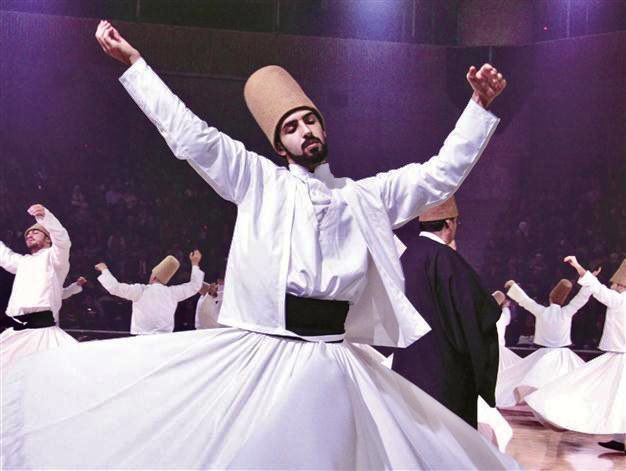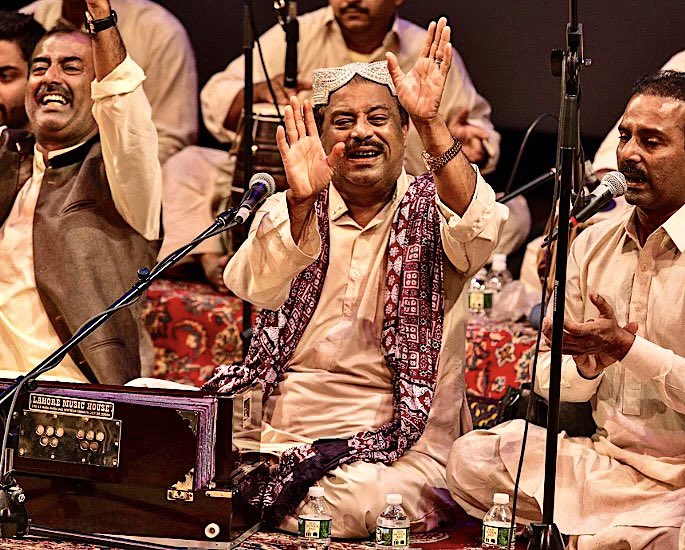Qawwali is a form of devotional singing related to Sufi philosophy. In this tradition, music plays an important part of the remembrance of God. Devotees try to overcome the limits of physical existence & concentrate on the Universal essence through music.
A thread on Qawwali…
A thread on Qawwali…

1/ Qawwali is a form of music practiced by Sufis to inspire religious devotion and instruction. Sufism is a mystical school of Islamic thought where truth & divine love are achieved through personal experience. 

2/ Qawwali is basically a form of mystical worship. Subcontinental Sufis often describe it as zikr, remembrance of Allah, which is the basic pillar of Sufism 

3/ The word Qawwali is derived from the Arabic word qul or qaula, meaning uttering or speaking. Subsequently, qawwal in Arabic refers to a person who speaks loudly or is a storyteller.
(Amjad Sabri from the Sabri Brothers)
(Amjad Sabri from the Sabri Brothers)

4/ The Turkish were the first to use the word qawwal, referring to the dervishes who performed the whirling chants of the Sufi saint, Jalaluddin Rumi. Thereafter, as the word traveled to India, followed by its Urdu adaptation the term qawwal was coined for people who sang Qawwali 

5/The genius of this deeply spiritual art form is that its hypnotic sound reaches the listener in a place beyond language, beyond rational thought. This is a music like no other; it is a path that leads to an awakening of the soul
A version of ‘Ya Hayyu Ya Qayyum’ by Sami Yusuf
A version of ‘Ya Hayyu Ya Qayyum’ by Sami Yusuf
6/ Qawaali emerged in what is now India and Pakistan in the 13th century, in close association with the Sufi and their Islamic mysticism.
Qawwali musicians in Rajasthan, India
Qawwali musicians in Rajasthan, India

7/ The Indian composer & Persian-language poet Amīr Khosrow 1253-1325 is the popularly acknowledged creator of qawwali & his works form the foundation of traditional qawwali
Amir Khusrow teaching his disciples - miniature from a manuscript of Majlis al-Ushshaq by Husayn Bayqarah
Amir Khusrow teaching his disciples - miniature from a manuscript of Majlis al-Ushshaq by Husayn Bayqarah

8/ Delhi's Sufi Amir Khusrow of the Chisti order of Sufis is credited with fusing the Persian, Arabic, Turkish, and Indian traditions in the late 13th century in India to create Qawwali as we know it today
Hazrat Nizamuddin Auliya With His Student Amir Khusro
Hazrat Nizamuddin Auliya With His Student Amir Khusro

9/ Qawwali has historically played a big role in the spread of Islam in South Asia as the experience of Qawwali helps both the performer & the listener to come close to experiencing the ultimate union with the divine (tawheed) through the awareness & belief in the oneness of God 

10/ In Pre Partition India, Qawwali became a common feature in the Dargah or Sufi Khanqah (a place where Sufi’s assemble to perform their rituals)
Rishi Kapoor charms his audience singing the famous qawwali “Pardah Hai Pardah” from Amar Akbar Anthony (1979)
Rishi Kapoor charms his audience singing the famous qawwali “Pardah Hai Pardah” from Amar Akbar Anthony (1979)

11/As Muslims started settling in the region they also introduced the devotional practice of Zikr continuous recitation of the names of Allah Almighty & that of the Holy Prophet (PBUH) in a specific tune & tempo. Zikr ceremonies evolved into Sama, featuring music & poetry recital 

12/ The word Sama is often still used in Central Asia and Turkey to refer to forms very similar to Qawwali, and in India, Pakistan and Bangladesh, the formal name used for a session of Qawwali is Mehfil-e-Sama. 

13/ Typically, there are a lot of people involved in a performance, with eight or nine players making music with harmoniums, tabla, dholak and other percussive instruments. 

14/ Qawwali music is performed with the intention of bringing listeners to a state of religious ecstasy and is known to hypnotize both performers and listeners
Madhubala impresses the Mughal prince in the classic qawwali “Teri Mehfil Mei.N Qismat” from Mughal-e-Azam (1960)
Madhubala impresses the Mughal prince in the classic qawwali “Teri Mehfil Mei.N Qismat” from Mughal-e-Azam (1960)

15/ The songs which constitute the qawwali repertoire are primarily in Persian, Urdu, Hindi, and Punjabi. The poetry is implicitly understood to be spiritual in its meaning. The central themes of qawwali are love, devotion and longing for the Divine. 

16/ Qawwalis are classified by their content into several categories:
A hamd
A naat
A manqabat
A marsiya
A ghazal
A kafi
A munajaat
Legendary Qawwali artist Abida Parveen
A hamd
A naat
A manqabat
A marsiya
A ghazal
A kafi
A munajaat
Legendary Qawwali artist Abida Parveen

17/ Ghazals are also a Sufi origin form of art. And though qawwali also like ghazals, speak of the devotion and love, they are rendered in the style of qawwali as opposed to ghazals which can be poetry and also the way of singing or rendering 

18/ The very musical structure that is used to compose Qawwali is in itself inspiring and elevating. The lyrics are mostly simple, involving just a few words. It is all about chanting a couplet aloud in a particular tone & rhythm.
Legendary Qawwali artist Nusrat Fateh Ali Khan
Legendary Qawwali artist Nusrat Fateh Ali Khan

19/ Qawwali is recognized by the way it is performed. The singers & musicians sit crossed-legged & with the accompaniment of the instruments the songs begin. As the tempo increases, there is clapping to the beats of the song & the pitch rises
Fareed Ayaz Qawwali Artist
Fareed Ayaz Qawwali Artist

20/ The songs are usually long, ranging from 15 to 20 minutes or more. And though the songs have a distinct Islamic meaning & purpose, they resonate with the listeners of all faiths. This is because the idea is to seek the divine power which is all empowering and all knowing. 

21/ The reaction to Qawwali is intended to bring everyone involved to a spiritual union with God. If you get the chance to see a performance it can be an intense and profoundly moving experience, no matter your personal faith. 

22/ Allah Hoo (God, just He!) is one such Qawwali that has been performed by many different qawwals, including the late Sabri Brothers and Nusrat Fateh Ali Khan, and at its core, is derived from a Sufi chant (zikr) that praises Allah as the one and only creator
23/ Qawwali features has a favorite playlist for every age group across the world. The singers have changed & so has the stage & the audience. More importantly, from being a deeply religious recital, the contemporary compositions have a universal appeal
Atif Aslam, Coke Studio
Atif Aslam, Coke Studio
24/ Sufi philosophy & Qawwali continue to attract audiences all over the world. Although many do not understand the idiomatic language used in Qawwalis, but can still relate to the fundamental concepts of love & participate in praise together is what continues the art of Qawwali 

Discover the art, heritage and history of Qawwali:
baytalfann.com/post/the-art-o…
baytalfann.com/post/the-art-o…
• • •
Missing some Tweet in this thread? You can try to
force a refresh






















